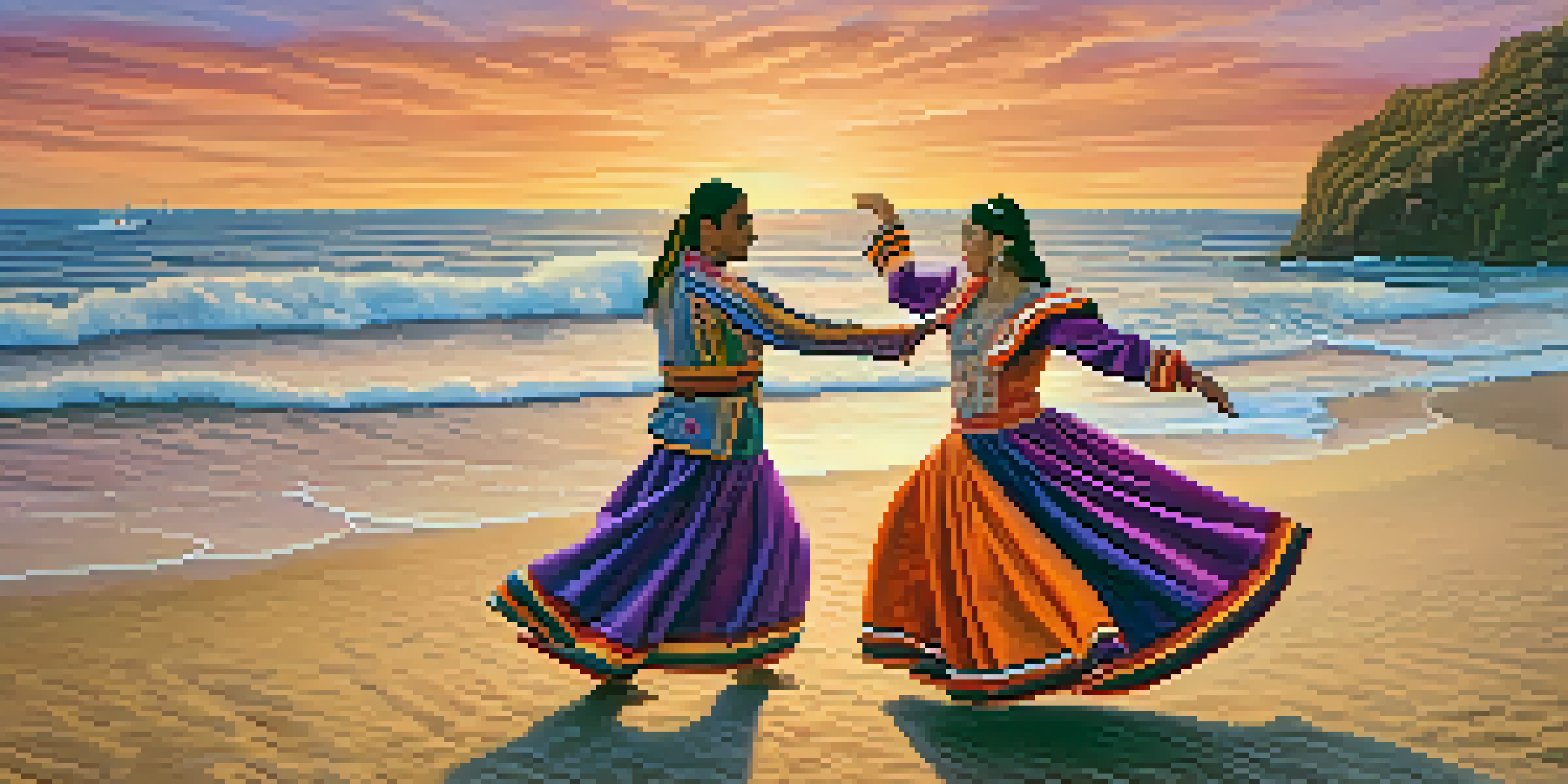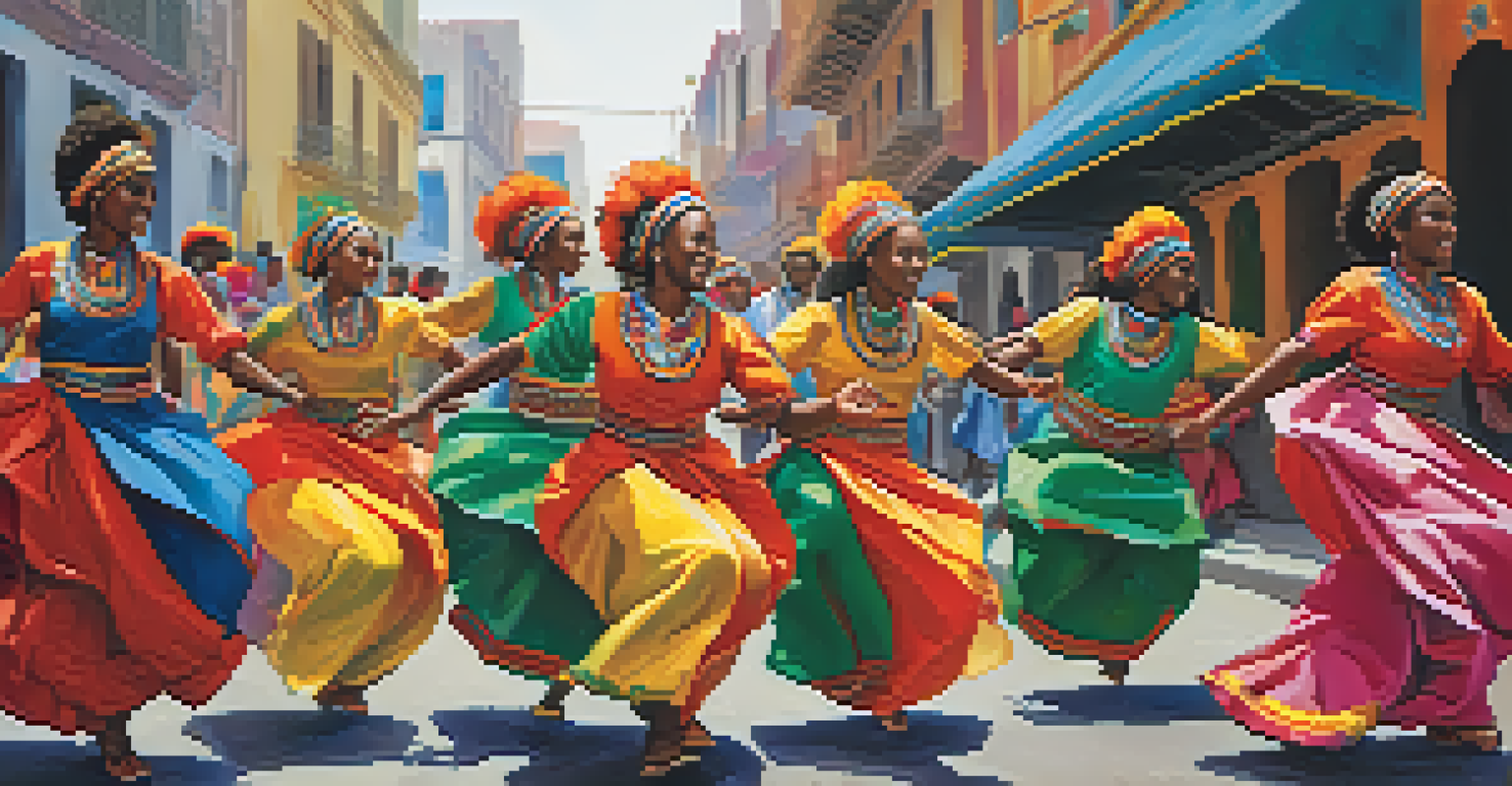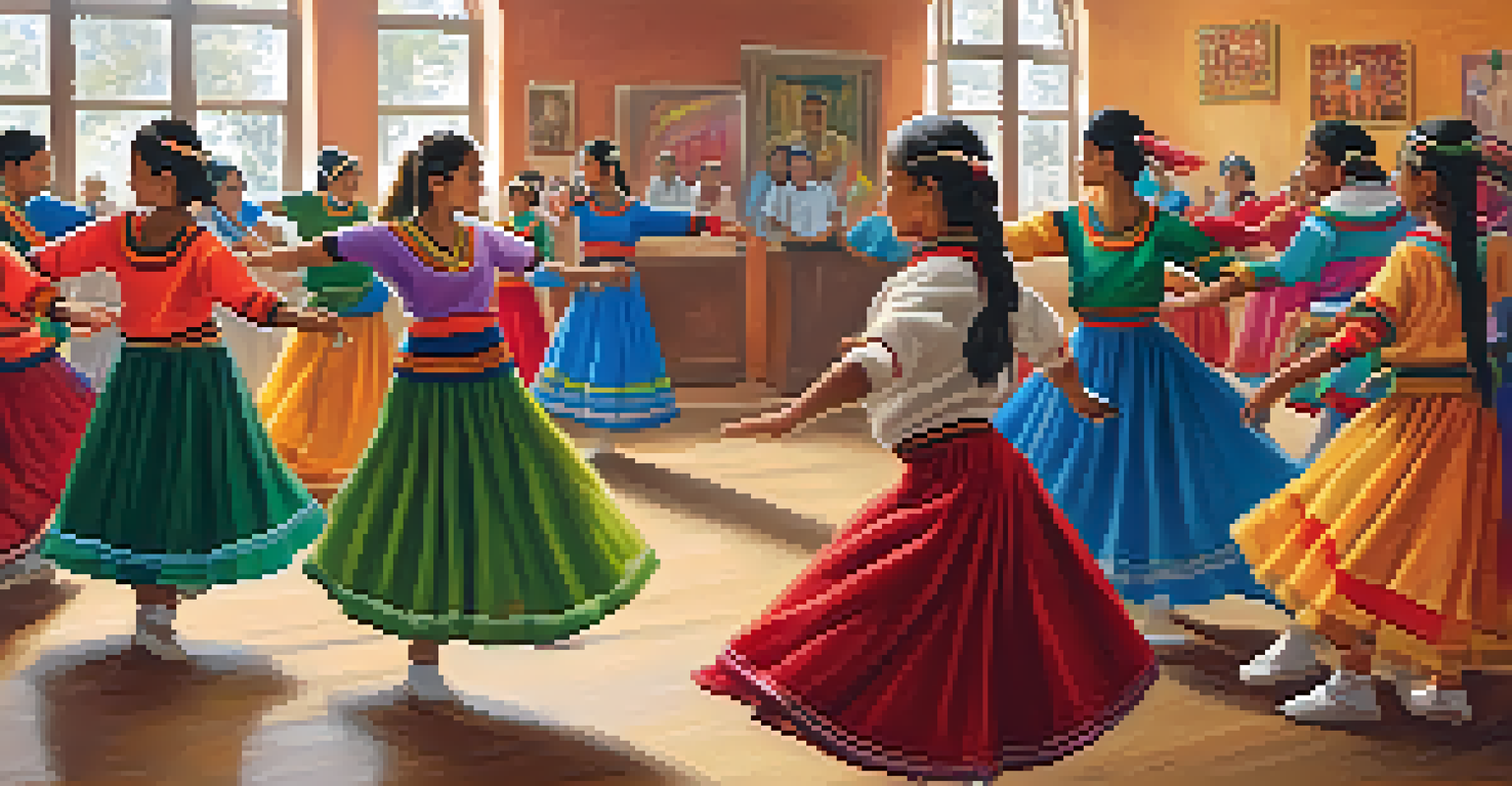Exploring Peruvian Influence on Modern Dance Forms Worldwide

Understanding the Roots of Peruvian Dance Traditions
Peruvian dance is rich with history, blending indigenous, African, and colonial influences. From the vibrant rhythms of the Andes to the coastal beats of the Afro-Peruvian culture, each region offers unique styles that tell a story. These traditional dances are not just performances; they are expressions of cultural identity and community.
Dance is the hidden language of the soul.
For instance, the Marinera, a graceful couple's dance, showcases the courtship rituals of coastal Peru, while the Huaylas dance reflects the agricultural practices of the Andean highlands. Each movement is steeped in meaning, capturing the essence of the Peruvian spirit. Understanding these roots helps us appreciate how they have influenced modern dance.
As these dances evolved, they began to incorporate elements from outside Peru, creating a dynamic fusion that resonates globally. This blending of styles exemplifies how traditional dance can adapt and thrive in contemporary contexts, paving the way for its influence on modern dance forms worldwide.
Key Elements of Peruvian Dance That Inspire Modern Choreography
One of the striking characteristics of Peruvian dance is its rhythmic complexity. Dancers often use intricate footwork and body movements that challenge traditional Western dance conventions. This complexity inspires choreographers around the world to explore new patterns and techniques in their works.

Moreover, the use of live music is a hallmark of Peruvian dance, adding an authentic vibrancy to performances. The incorporation of traditional instruments like the cajón, charango, and pan flutes into modern choreography enriches the auditory experience, engaging the audience on multiple levels. This emphasis on live music encourages contemporary dancers to explore how sound can enhance movement.
Cultural Roots Shape Peruvian Dance
Peruvian dance reflects a rich blend of indigenous, African, and colonial influences, each style telling a unique cultural story.
Additionally, the storytelling aspect of Peruvian dance is a profound influence. Dancers convey narratives through their movements, inviting audiences to connect emotionally. This focus on storytelling has led modern choreographers to emphasize character and narrative in their works, creating performances that resonate deeply with viewers.
The Role of Cultural Exchange in Dance Evolution
Cultural exchange has played a crucial role in the evolution of dance, allowing different styles to intermingle and inspire one another. As dancers and choreographers travel and share their traditions, they introduce new elements to their art forms. This exchange is particularly evident in how Peruvian dance has found its way into contemporary dance scenes around the globe.
The dance is a poem of which each movement is a word.
Festivals and workshops celebrating Peruvian culture provide platforms for this exchange, where dancers from diverse backgrounds come together to learn and collaborate. These events foster a sense of community and mutual respect, encouraging participants to blend traditional Peruvian movements with their own styles. The resulting fusion creates unique dance forms that reflect a global perspective.
Moreover, social media has accelerated this cultural exchange, allowing dancers to showcase their work and connect with international audiences. Through platforms like Instagram and TikTok, Peruvian dance is gaining visibility, inspiring dancers worldwide to incorporate its vibrant elements into their own routines.
Peruvian Dance Styles Making Waves in Contemporary Dance
Several Peruvian dance styles have gained recognition in the contemporary dance scene, with the Afro-Peruvian dances leading the charge. The lively rhythms of dances like the Festejo have been embraced by modern choreographers, infusing their works with infectious energy and dynamic movement. This cross-pollination enriches both the source and the contemporary forms.
Another style, the Andean Huaylas, emphasizes strong footwork and intricate choreography that challenges dancers physically. Modern dance companies often incorporate these elements to create visually stunning performances that celebrate the strength and agility of the human body. The influence of these traditional forms can be seen in dance competitions and performances worldwide.
Cultural Roots Shape Peruvian Dance
Peruvian dance is a vibrant tapestry of indigenous, African, and colonial influences, reflecting cultural identity and community through its unique styles.
Additionally, the incorporation of traditional costumes in contemporary performances adds a layer of visual storytelling. The vibrant colors and intricate designs of Peruvian attire not only enhance the aesthetic appeal but also pay homage to cultural heritage. This blend of tradition and modernity captivates audiences and elevates the performance experience.
Influence of Peruvian Dance on Global Dance Competitions
Global dance competitions have increasingly recognized the influence of Peruvian dance, showcasing its vibrant styles on international stages. Competitors often incorporate elements from Peruvian dance, whether through choreography or costume design, to stand out and celebrate diversity. This exposure helps to elevate Peruvian dance forms, introducing them to new audiences.
One notable example is the incorporation of the Marinera in competitions, where dancers use its intricate footwork and graceful movements to impress judges and spectators alike. The passion and energy of this dance resonate strongly, allowing competitors to connect with audiences on an emotional level. This connection can often lead to an appreciation of Peruvian culture and its artistic expressions.
Moreover, workshops and classes focusing on Peruvian dance techniques are becoming increasingly popular in dance schools worldwide. This accessibility encourages dancers from various backgrounds to explore the techniques and philosophies behind these traditional forms, fostering a deeper understanding and appreciation of the cultural narratives they embody.
The Future of Peruvian Dance in a Globalized World
As the world becomes more interconnected, the future of Peruvian dance looks promising. Its ability to adapt and evolve while retaining its cultural roots positions it well within the global dance landscape. Dancers and choreographers continue to explore innovative ways to integrate Peruvian styles into contemporary works, ensuring their relevance for future generations.
Educational initiatives that focus on preserving traditional Peruvian dance are essential for maintaining this cultural heritage. As more people engage with these forms, they contribute to the ongoing narrative of Peruvian dance and its influence on modern choreography. This education fosters respect and appreciation for the origins of these dance styles.
Global Influence of Peruvian Dance
Peruvian dance styles, such as the Marinera and Afro-Peruvian dances, are increasingly recognized in contemporary dance scenes, inspiring choreographers worldwide.
Ultimately, the continued blending of Peruvian dance with global influences will create exciting new forms. This evolution not only keeps the spirit of the dance alive but also enriches the global dance community, creating a tapestry of movement that celebrates diversity and cultural exchange.
Celebrating the Vibrancy of Peruvian Dance Today
Today, Peruvian dance is celebrated not only within Peru but also on international platforms. Festivals, performances, and workshops dedicated to these vibrant styles highlight their significance and appeal. This celebration invites audiences to experience the richness of Peruvian culture through dance, fostering appreciation and understanding.
In cities around the world, Peruvian dance troupes are gaining recognition for their captivating performances that showcase the depth and variety of these traditions. From the rhythmic beats of Afro-Peruvian music to the elegant movements of the Marinera, each performance is a vibrant celebration of life and culture. Such visibility encourages a greater interest in learning about and participating in these dance forms.

Moreover, as more dancers embrace and adapt Peruvian styles, the global dance community becomes a richer and more diverse space. This celebration of Peruvian dance not only honors its origins but also ensures that it continues to inspire future generations, leaving a lasting legacy in the world of modern dance.